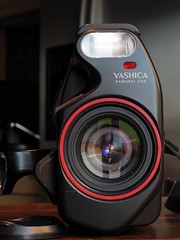Yashica Samurai X3.0
| ||
|
The unusual Samurai series was begun by Kyocera in 1987 with the X3.0. The Samurai completely discarded prior ideas about still-camera design, and instead creating a body more resembling the compact video cameras which were becoming popular at the time. The Samurai is a true SLR, exposing half-fame (17×24 mm) images—a format which had always been more accepted within the Japanese market (for example in the Olympus Pen series). The Samurai X3.0 can be found with both Yashica and Kyocera branding, and with accents in either red or teal blue colors.
The X3.0 includes an integral, autofocus 25–75 mm zoom lens—a 3x zoom range (the later Samurai X4.0 zoomed in to 100 mm, a 4x range). Besides autofocus, the camera has motorized film advance and rewind, and power zooming using WIDE/TELE pushbuttons. A small "RS" (reset) button is also provided, in the event the camera's microprocessor locks up.
Specifications
- Film/frame format: 35mm / 18×24mm
- Lens: Yashica Zoom Lens 1:3,5-4,3/25-75mm using 14 elements
- Shutter: Electronical central shutter with speeds 2 to 1/500 sec.
- Autofocus lock with half-press on shutter release
- Integral electronic flash, activates automatically
- Sequence-shooting and 10 sec. self-timer drive modes
- Optional date/time imprinting at bottom right of image; three date formats
- DX code sensing, ISO 50–3200 (default ISO 100 for non-coded cassettes)
- Eyepiece diopter correction, +1 to -4
- Battery: 6v lithium (2CR5)
Sources
- Yashica Samurai X3.0 four-language instruction manual, from Mike Butkus' OrphanCameras.com
- "Samurai: Autofocus Zoom Half-frame SLR!" in "Keppler's SLR World," January 1988 Popular Photography (Vol. 95, No. 1; pages 66–67).

|
| image by mgtelu (Image rights) |

